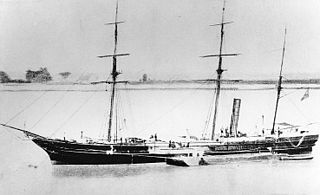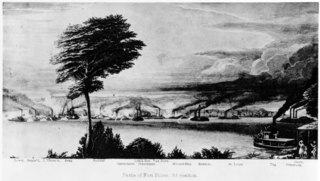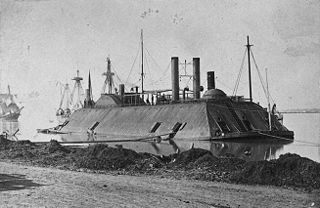
CSS McRae was a Confederate gunboat that saw service during the American Civil War. Displacing around 680 tons, she was armed with one 9-inch (229 mm) smoothbore and six 32-pounder (15 kg) smoothbore cannon.
USS New London was a screw steamer of the Union Navy during the American Civil War. She was outfitted with a Parrott rifle and 32-pounders, and was assigned as a gunboat in the Union blockade of the Confederate States of America.

CSS Oregon was a wooden sidewheel steamer that served as a gunboat in the Confederate States Army during the American Civil War. Built in 1846 for the Mobile Mail Line, she transported mail between New Orleans, Louisiana, and Mobile, Alabama, before the war. In 1861, she was seized by the Governor of Louisiana, Thomas Overton Moore, and served as a blockade runner before being selected for use by the Confederate Army. After transferring men and supplies to Ship Island, she was formally converted into a gunboat and armed with four cannon. Remaining behind on Lake Pontchartrain when many Confederate warships were transferred up the Mississippi River, Oregon served in the Mississippi Sound and Pass Christian areas. She took part in several minor actions involving USS New London, two of which resulted in the Confederates moving into shallow water to avoid close-range action, and the third ending when the Confederate ships abandoned the Pass Christian area. In April 1862, Union pressure confined her and other Confederate ships to Lake Pontchartrain. Later that month, with Union forces closing in on New Orleans, Oregon was sunk as a blockship. Her wreck was removed and destroyed in the early 1870s.

USS Varuna was a screw steamer acquired by the Union Navy during the American Civil War. Early in the war, the Union Navy was tasked with blockading the Confederate coastline. In order to complete the goal, the purchase of a number of additional ships was necessary. One of the vessels purchased was Varuna, which was still under construction when the sale occurred on 31 December 1861. Commissioned in February 1862, she traveled to join the West Gulf Blockading Squadron. The squadron was under the command of Flag Officer David Glasgow Farragut and was tasked with the capture of New Orleans, Louisiana.

The Battle of Plum Point Bend took place in Tennessee during the American Civil War on May 10, 1862, on the Mississippi River, between ships of the Confederate River Defense Fleet and the Union Western Flotilla. Fighting for control of the Mississippi had been ongoing since the prior year as Union forces pushed downriver to Fort Pillow, about 50 miles (80 km) north of Memphis. The Union had been using mortar boats to bombard Fort Pillow, and had settled into a regular routine. The Union's daily tactic was to send a single mortar boat guarded by an ironclad warship to a position further downriver to shell the fort, while the rest of the fleet remained upriver. On the morning of May 10, the Confederates attacked in the hope of capturing the guard ironclad and then surprising the rest of the Union fleet.

USS John P. Jackson was a sidewheel steamer acquired by the Union Navy during the beginning of the American Civil War. Built in 1860, John P. Jackson was used as a ferry by the New Jersey Rail Road and Transportation Company. In February 1861, she ferried President-elect Abraham Lincoln on his way to his inauguration. She was purchased for use in the American Civil War on 6 November. Commissioned for military service on 14 February 1862, she was sent to Ship Island. On 4 April, she was part of a battle with Confederate vessels near Pass Christian, Mississippi. That same day, she captured the blockade runner P. C. Wallis. In April, she bombarded Confederate-held Fort Jackson and Fort St. Philip. Next month, John P. Jackson participated in a scout of Lake Pontchartrain.

CSS General Earl Van Dorn was a cottonclad warship used by the Confederate States of America during the American Civil War. She was purchased for Confederate service in New Orleans, Louisiana, in early 1862 to serve with the River Defense Fleet. She was converted into a cottonclad warship by installing an iron-covered framework of timbers on her bow that served as a ram, and protecting her machinery with timber bulkheads packed with cotton. A sidewheel steamer, she was 182 feet (55 m) long and was armed with a single 32-pounder cannon on the bow.

USS Calhoun was a captured Confederate steamer and blockade runner acquired by the Union Navy from the prize court during the American Civil War.
USS Massachusetts was a large steamer acquired by the U.S. Navy prior to the American Civil War.

USS Sumter was a 525-ton sidewheel paddle steamer captured by the Union Navy during the Union blockade of the American Civil War.
CSS New Orleans was a floating battery used by the Confederate States Navy during the American Civil War. Converted from a floating drydock in 1861, she was commissioned on October 14, 1861. The vessel was unable to move under her own power and lacked facilities for her crew to live aboard, so CSS Red Rover was used to move the floating battery and house her crew. She was then sent upriver to assist in the Confederate defense of Columbus, Kentucky, arriving there in December. After the Confederates abandoned Columbus in March 1862, New Orleans was moved to Island No. 10 near New Madrid, Missouri. The Confederate defenders of Island No. 10 surrendered on April 8, and New Orleans was scuttled that day. Not fully sunk, the floating battery drifted downriver to the New Madrid area, where it was captured by Union forces. In Union hands, New Orleans was used as a floating drydock until the Confederates burned her in August or September 1863.

The Battle of the Head of Passes was a bloodless naval battle of the American Civil War. It was a naval raid made by the Confederate river defense fleet, also known as the “mosquito fleet” in the local media, on ships of the Union blockade squadron anchored at the Head of Passes. The mosquito fleet deployed three fire rafts, which were ignited and followed the ironclad ram CSS Manassas into the action. The attack occurred after moonset in the early hours of October 12, 1861, and routed the Union fleet, which fled in disorder down the Southwest pass of the delta. After sunrise Commodore George N. Hollins, running low on ammunition and fuel, ordered the mosquito fleet to withdraw upriver.

CSS Ivy was a sidewheel steamer and privateer purchased by Commodore Lawrence Rousseau for service with the Confederate States Navy, and chosen by Commodore George Hollins for his Mosquito Fleet. The Mosquito Fleet was a group of riverboats converted to gunboats, and used to defend the Mississippi River in the area of New Orleans during the American Civil War.

The Battle of Lucas Bend took place on January 11, 1862, near Lucas Bend, four miles north of Columbus on Mississippi River in Kentucky as it lay at the time of the American Civil War. In the network of the Mississippi, Tennessee and Ohio rivers, the Union river gunboats under Flag Officer Andrew Hull Foote and General Ulysses S. Grant sought to infiltrate and attack the Confederate positions in Tennessee. On the day of the battle, the Union ironclads Essex and St Louis, transporting troops down the Mississippi in fog, engaged the Confederate cotton clad warships General Polk, Ivy and Jackson and the gun platform New Orleans at a curve known as Lucas Bend in Kentucky. The Essex, under Commander William D. Porter, and the St Louis forced the Confederate ships to fall back after an hour of skirmishing during which the Union commander was wounded. They retreated to the safety of a nearby Confederate battery at Columbus, where the Union vessels could not follow.
CSS General Polk was a sidewheel steamer used as a warship by the Confederate States Navy during the American Civil War. Launched in 1852 at New Albany, Indiana, as Ed Howard, the vessel was originally a packet steamer between Nashville, Tennessee, and New Orleans, Louisiana. After the outbreak of the war, the Confederate government purchased her for $8,000. She was commissioned into military service on October 22, 1861, and sent to Columbus, Kentucky the following month. On January 11, 1862, General Polk participated in the Battle of Lucas Bend. After the Confederates abandoned Columbus, General Polk served in the Island No. 10 and New Madrid, Missouri, area, until those positions as well fell. She was then stationed at Fort Pillow and Memphis, Tennessee, before withdrawing up the Yazoo River. On June 26, General Polk was burned at Liverpool Landing, Mississippi, along with two other Confederate ships, to prevent their capture by Union forces.

CSS Pickens was a Cushing-class schooner revenue cutter that saw service in the navies of the United States and Confederate States of America. Built as Robert McClelland in Somerset, Massachusetts, in 1853, she served along the coasts of Louisiana and Texas before transferring her crew and officers to USRC Washington in 1859 and heading to New York for repairs. In 1860, Robert McClelland reported to South West Pass, Mississippi, and was permanently assigned to New Orleans, Louisiana, later that year. After the 1861 secession of Louisiana, her commander turned her over to the state. She entered Confederate service on February 18 and was renamed Pickens. Pickens played a minor role in the Battle of the Head of Passes before being burned to prevent its capture on April 25, 1862, after Union Navy forces entered New Orleans.
CSS Tuscarora was a sidewheel steamer that briefly served as a gunboat in the Confederate States Navy at the beginning of the American Civil War. She was about 100 feet (30 m) long, displaced 400 short tons, and was manned by a 25-man crew. The vessel was purchased in 1861 from the Southern Steamship Company by Confederate authorities in New Orleans, Louisiana. Armed with two cannons, Tuscarora was engaged in the Battle of the Head of Passes on October 12, 1861. Ordered up the Mississippi River to Columbus, Kentucky, in November, she was destroyed on November 23, 1861, when a fire of unknown origin started in her boilers and spread to the ship's munitions.
CSS Maurepas was a sidewheel steamer that briefly served as a gunboat in the Confederate States Navy during the American Civil War. Built in 1858 in Indiana as Grosse Tete, the vessel was used in commercial trade until 1860 and then delivered mail until 1861, when she was acquired by the Confederate Navy.
CSS Carondelet was a sidewheel steamer that served in the Confederate States Navy during the American Civil War. Construction for the vessel started in 1861, and she was launched on January 25, 1862, and commissioned on March 16. Her sister ship was CSS Bienville. On April 4, Carondelet, along with CSS Oregon and CSS Pamlico, took part in a small naval action near Pass Christian against USS New London, USS John P. Jackson, and the troop transport USS Henry Lewis. Carondelet suffered damage to her wheel during the fight, and likely fired the only two shots that struck John P. Jackson. Later that month, with the Confederates abandoning New Orleans, Louisiana, Carondelet was scuttled by her crew in either Lake Pontchartrain, the Tchefuncte River, or the Bogue Falaya River.
CSS Pontchartrain was a gunboat that served in the Confederate States Navy during the American Civil War. Built in 1859 for passenger and cotton trade, she was purchased by the Confederates in October 1862. After seeing action against Union land positions during the campaigns for New Madrid, Missouri, and Island Number Ten, she was transferred to serve on the Arkansas River and the White River. In June 1862, two of her cannons were taken to a land fortification at St. Charles, Arkansas, where part of her crew saw action in the Battle of St. Charles while manning the guns. Her other cannons were then offloaded at Fort Hindman, where more of her crew were captured while fighting on land at the Battle of Arkansas Post in January 1863. Pontchartrain herself remained inactive at Little Rock, Arkansas, and was burned to prevent capture in September 1863 when the Confederates evacuated the city.












